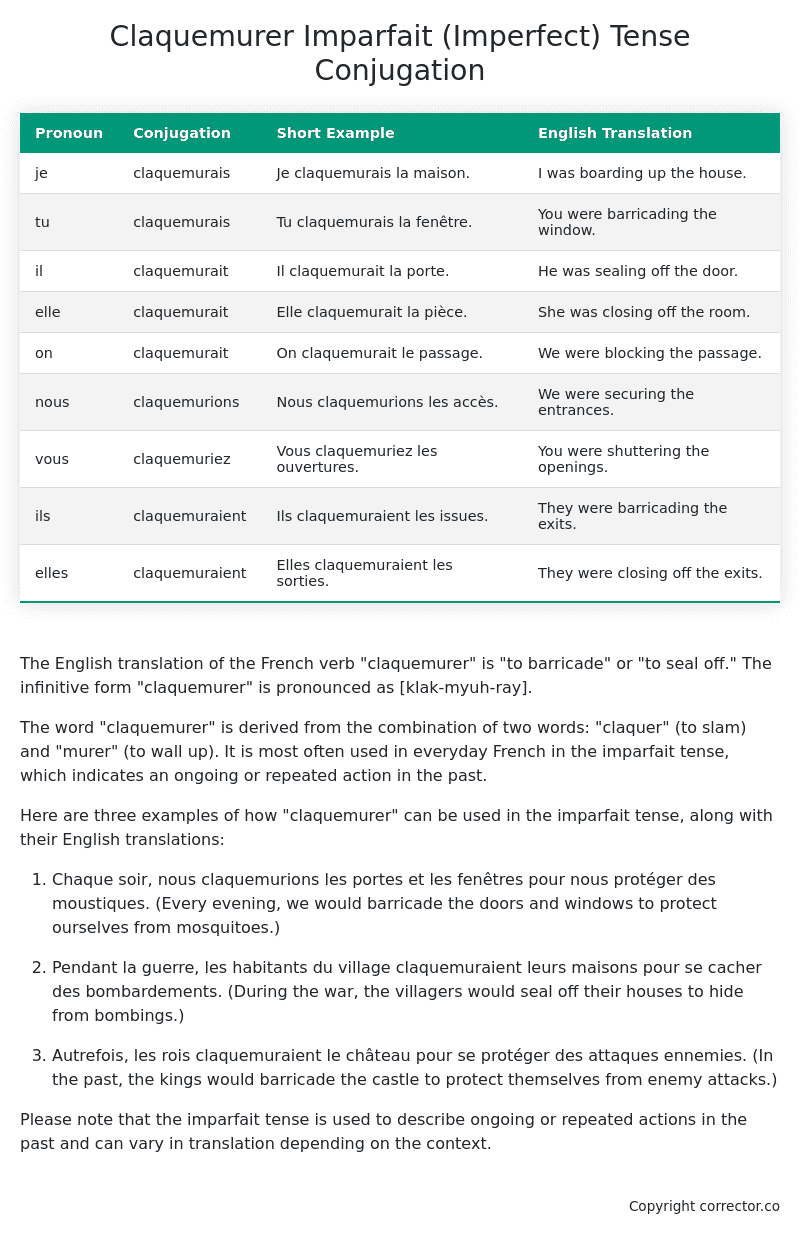Imparfait (Imperfect) Tense Conjugation of the French Verb claquemurer
Introduction to the verb claquemurer
The English translation of the French verb “claquemurer” is “to barricade” or “to seal off.” The infinitive form “claquemurer” is pronounced as [klak-myuh-ray].
The word “claquemurer” is derived from the combination of two words: “claquer” (to slam) and “murer” (to wall up). It is most often used in everyday French in the imparfait tense, which indicates an ongoing or repeated action in the past.
Here are three examples of how “claquemurer” can be used in the imparfait tense, along with their English translations:
-
Chaque soir, nous claquemurions les portes et les fenêtres pour nous protéger des moustiques.
(Every evening, we would barricade the doors and windows to protect ourselves from mosquitoes.) -
Pendant la guerre, les habitants du village claquemuraient leurs maisons pour se cacher des bombardements.
(During the war, the villagers would seal off their houses to hide from bombings.) -
Autrefois, les rois claquemuraient le château pour se protéger des attaques ennemies.
(In the past, the kings would barricade the castle to protect themselves from enemy attacks.)
Please note that the imparfait tense is used to describe ongoing or repeated actions in the past and can vary in translation depending on the context.
Table of the Imparfait (Imperfect) Tense Conjugation of claquemurer
| Pronoun | Conjugation | Short Example | English Translation |
|---|---|---|---|
| je | claquemurais | Je claquemurais la maison. | I was boarding up the house. |
| tu | claquemurais | Tu claquemurais la fenêtre. | You were barricading the window. |
| il | claquemurait | Il claquemurait la porte. | He was sealing off the door. |
| elle | claquemurait | Elle claquemurait la pièce. | She was closing off the room. |
| on | claquemurait | On claquemurait le passage. | We were blocking the passage. |
| nous | claquemurions | Nous claquemurions les accès. | We were securing the entrances. |
| vous | claquemuriez | Vous claquemuriez les ouvertures. | You were shuttering the openings. |
| ils | claquemuraient | Ils claquemuraient les issues. | They were barricading the exits. |
| elles | claquemuraient | Elles claquemuraient les sorties. | They were closing off the exits. |
Other Conjugations for Claquemurer.
Le Present (Present Tense) Conjugation of the French Verb claquemurer
Imparfait (Imperfect) Tense Conjugation of the French Verb claquemurer (You’re reading it right now!)
Passé Simple (Simple Past) Tense Conjugation of the French Verb claquemurer
Passé Composé (Present Perfect) Tense Conjugation of the French Verb claquemurer
Futur Simple (Simple Future) Tense Conjugation of the French Verb claquemurer
Futur Proche (Near Future) Tense Conjugation of the French Verb claquemurer
Plus-que-parfait (Pluperfect) Tense Conjugation of the French Verb claquemurer
Passé Antérieur (Past Anterior) Tense Conjugation of the French Verb claquemurer
Futur Antérieur (Future Anterior) Tense Conjugation of the French Verb claquemurer
Subjonctif Présent (Subjunctive Present) Tense Conjugation of the French Verb claquemurer
Subjonctif Passé (Subjunctive Past) Tense Conjugation of the French Verb claquemurer
Subjonctif Imparfait (Subjunctive Imperfect) Tense Conjugation of the French Verb claquemurer
Conditionnel Présent (Conditional Present) Tense Conjugation of the French Verb claquemurer
Conditionnel Passé (Conditional Past) Tense Conjugation of the French Verb claquemurer
Conditionnel Passé II (Conditional Past II) Tense Conjugation of the French Verb claquemurer
L’impératif Présent (Imperative Present) Tense Conjugation of the French Verb claquemurer
L’impératif Passé (Imperative Past) Tense Conjugation of the French Verb claquemurer
L’infinitif Présent (Infinitive Present) Tense Conjugation of the French Verb claquemurer
L’infinitif Passé (Infinitive Past) Tense Conjugation of the French Verb claquemurer
Le Participe Présent (Present Participle) Tense Conjugation of the French Verb claquemurer
Le Participe Passé (Past Participle) Tense Conjugation of the French Verb claquemurer
Struggling with French verbs or the language in general? Why not use our free French Grammar Checker – no registration required!
Get a FREE Download Study Sheet of this Conjugation 🔥
Simply right click the image below, click “save image” and get your free reference for the claquemurer imparfait tense conjugation!

Claquemurer – About the French Imparfait Tense
NOTE: To take a deep dive into all the French tenses then see our article on Mastering French Tense Conjugation.
Formation of the Imparfait Tense
For regular -er verbs:
For regular -ir verbs
For regular -re verbs
Common Everyday Usage Patterns
Description of Past Habits
Background Information
Mental and Emotional States
It’s employed to express emotions, thoughts, or physical sensations in the past. For example: “J’étais content quand il est arrivé.” (I was happy when he arrived.)
Ongoing Actions
Points to Note About the Imparfait Tense
Passé Composé vs. Imparfait
Conditional
Si Clauses
Narration
I hope you enjoyed this article on the verb claquemurer. Still in a learning mood? Check out another TOTALLY random French verb imparfait conjugation!


